Economic implications of phytase use in layer nutrition
The effectiveness of phytase in increasing the availability of phosphorus from plant-derived feedstuffs has been observed for several years. In most instances the exogenous phytase used to supplement poultry diets is obtained from an Aspergillus species which usually produces 3-phytase, a rather non-specific phosphomonoesterase that catalyses the dephosphorylation of myoinositol hexakisphosphate (phytate) and produces orthophosphate, which can be absorbed by monogastric animal species. Phytate may constitute 1- 2 % by weight of many cereals and oilseeds. Typically about 60-90% of the phosphorus in plant seeds is present in a phytate-bound form (Cheryan, 1980).
Supplementation of poultry diets with phytase the world over has resulted in the enhancement of phosphorus availability from plant-derived feedstuffs. Commonly used phytase additions to layer diets, i.e. 136 FTU/lb. (or equivalent) generally increases the availability of the phytate phosphorus content of layer diets by the equivalent of approximately 0.1%, which effectively reduces the amount of phosphorus that must be added to the diet as an inorganic phosphate source. In terms of dicalcium phosphate (18.5% P), the amount added to typical layer diets would be decreased by approximately 11 lbs/ton. In terms of monocalcium phosphate (21% P), the amount added would be decreased by approximately 9.4 lbs/ton of feed. Not only might the per unit cost of feed be reduced with the addition of phytase, but a substantial reduction in the amount of phosphorus excreted into the environment occurs. It is generally accepted that phytase also increases digestibility of calcium, probably 65-85% of its effect on phosphorus.
The effect of phytase in increasing the availability of phosphorus and calcium in plant-derived feedstuffs does not appear to be confined to these two nutrients. It is well established that phytate in its native state is also complexed with various cations i.e. protein, lipids, and starch (Cosgrove, 1966). It thus becomes easy to speculate that supplemental microbial phytase may release phytate-bound protein and thus improve the bioavailability of protein and associated nitrogenous compounds such as amino acids.
Understanding the chemistry of the phytic acid molecule assists in understanding its observed negative impact on dietary nutrient availability. Phytic acid is strongly negatively charged (6 reactive phosphate groups) over a wide pH range, thus exhibiting tremendous potential for complexing positively charged molecules such as cations or proteins. Typically phytate-bound nutrients are poorly available in the digestive tract of the monogastric animal due principally to the lack of adequate quantities of phytase enzymes to cleave the phytate molecule (Cosgrove, 1980; Reddy et al., 1982; Jongbloed et al., 1993). It has also been observed that phytate inhibits a number of digestive enzymes such as pepsin, "-amylase and trypsin (Ravindran et al., 1995). Thus it comes as no surprise that numerous studies have documented the nutritional implications of phytate in binding macro and microelements in plant-derived feedstuffs used in monogastric rations.
Among the earliest reports of the positive effects of supplemental phytase on protein and amino acid availability was a publication by van der Klis and Versteegh in 1991. Subsequent studies have confirmed these initial reports. Apparently such effects on protein and amino acids are a consequence of dietary phytase preventing the negative effects of phytate on protein and starch digestibility by hydrolyzing the phytate-protein-starch complexes and returning dietary protein, amino acids and starch to soluble and absorbable forms in the gastrointestinal tract. This apparent effect on starch-phytate complexes is assumed to account, at least in part, for the observed effect of phytase in increasing the energy content of feed.
Calculating the economic impact of phytase supplementation
The preponderance of published literature attests to the positive effects of phytase addition to diets of monogastric animals. However, the economic consequence of such positive results are often difficult to measure in meaningful terms. The question thus becomes “what in monetary terms is the addition of appropriate quantities of phytase to the diet worth?” The economic worth of phytase addition to monogastric diets may be evaluated using quantitative data on the increases in nutrient availability mediated by phytase. For example, published literature generally supports an increase in available phosphorus of about 0.1% in typical layer diets when the equivalent of 136 FTU of phytase are added per lb of diet. Based on an inclusion rate of 136 FTU (or equivalent) per lb of feed, the nutrient values ascribed to phytase for phosphorus would be 200% for available and 200% for total phosphorus to achieve 0.1% phosphorus (available and total). The economic value of 0.1% available/total phosphorus above the cost of the added phytase is illustrated in Table 1 and is about $0.30/ton of feed (high energy). A cost of $12.00 per 100 lbs for dicalcium phosphate and a cost for phytase of $1.00 per ton of feed were used in obtaining the results in Tables 1-5. However, it can be expected that as the price of dietary phosphate sources increases, the value of phytase will also increase. In a high energy ration (1345 kcal/lb) phytase is approximately $0.12 per ton more valuable than in a low energy formulation (1265 kcal/lb). This apparently is due to the cost of calories from grain being less compared to the cost of calories from feed-grade fat. Thus as the price of feed-grade fat changes, the value of phytase may also change.
Table 1. Effect of phytase addition on cost of layer formulas as influenced by phosphorus contribution to cost of low or high energy diets.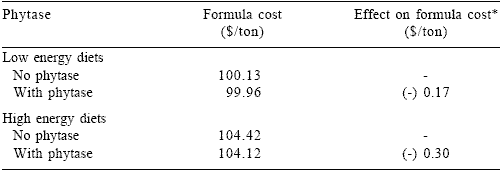
*Formula costs reflect savings above the cost of phytase addition.
Scenarios similar to the one used for evaluating the economic influence of phytase addition on available and total phosphorus were used to evaluate the economic impact of phytase addition on other nutrients of economic interest. (Tables 2-5). The nutrient contributions resulting from the addition of 136 FTU (or equivalent) per lb of phytase were assumed to be: metabolizable energy, 6786 Kcal/lb; protein, 440%; lysine, 50%; methionine, 10%; methionine and cystine, 25%; arginine, 50%; and tryptophan, 5%.
It thus becomes evident that the economic benefit of adding phytase to layer rations is not a constant value but is dependent upon the cost of each dietary essential nutrient whose availability is increased by addition of phytase. The cumulative net economic benefits of phytase addition, i.e. 136 FTUs/lb (or equivalent) to layer diets based on the parameters used in this report, may vary from a low of $0.82 per ton to a high of $1.47 per ton (Tables 1-5) depending upon the enhanced dietary nutrient contributions assumed from the addition of phytase and the cost of these same nutrients in typical ingredients used in layer rations.
Table 2.Effect of phytase addition on cost of layer formulas as influenced by calcium contribution.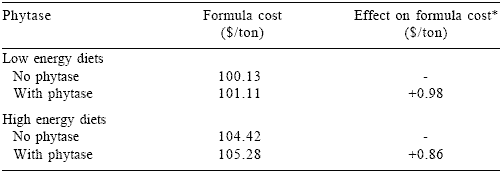
*Formula costs reflect savings above the cost of phytase addition.
Table 3. Effect of phytase addition on cost of layer formulas as influenced by energy contribution to cost of high and low energy diets.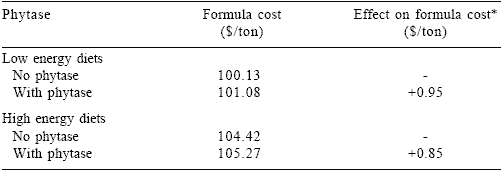
*Formula costs reflect savings above the cost of phytase addition.
Table 4.Effect of phytase addition on cost of layer formulas as influenced by the contribution of protein and amino acids to cost of high and low energy diets.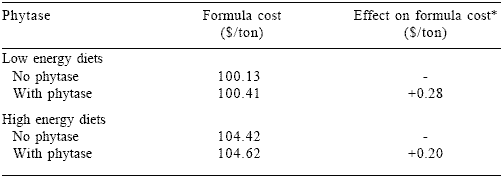
*Formula costs reflect savings above the cost of phytase addition.
Table 5. Effect of phytase addition on cost of layer formulas as influenced by nutrient density.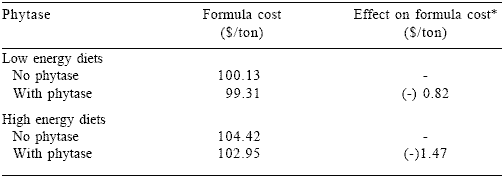
*Formula costs reflect savings above the cost of phytase addition.
References
Author: WOODIE P. WILLIAMSCheryan, M., 1980. Phytic acid interactions in food systems. CRC Crit. Rev. Food Sci. 13:297-335.
Cosgrove, D.J., 1966. The chemistry and biochemistry of inosital polyphosphates. Rev. Pure & Appl. Chem. 16:209-224.
Cosgrove, D.J., 1980. Inosital phosphates: their chemistry, biochemistry and physiology. Elsevier Scientific Publishing Company, New York, Amsterdam, p.175.
Jongbloed, A.W., P.A. Kemme and Z. Mroz. 1993. The role of microbial phytases in pig production, In: Enzymes in Animal Production (C. Wenk and M. Boessinger, eds), Proceedings of the 1st Symposium, Kartause Ittingen, Switzerland, p. 173-180.
Ravindran, V., W.L. Bryden and E.T. Kornegay. 1995. Phytates: occurrence, bioavailability and implications in poultry nutrition. Poult. & Avian Biol. Rev. 6:125-143.
Reddy, N.R., S.K. Sathe and D.K. Salunkhe. 1982. Phytates in legumes and cereals. Adv. Food Res. 28:1-92.
Van der Klis, T.D. and Verstaagh, H.A.J., 1991. Ileal absorption of P in light-weight white laying hens using microbial phytase and various calcium contents in laying hen feed. Spelderhalt Publication No. 563, Beekbergen, The Netherlands.
Clemson University, Clemson, South Carolina, USA


United States






